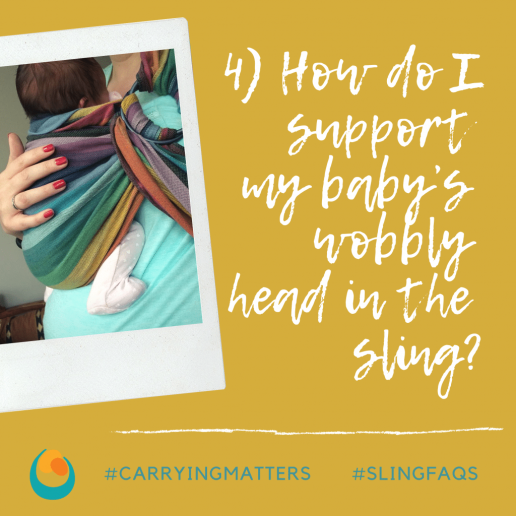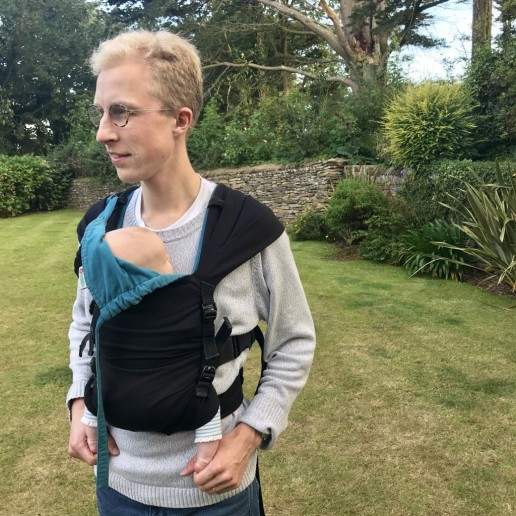How can I support my baby’s wobbly head in their sling?
Young babies have not yet learned how to co-ordinate all their muscles to match the sensory feedback pouring into their brains; learning neck control to support the head confidently takes time. Sleepy babies have relaxed muscles and heads can loll around. This can be worrying for parents; but it is all part of how babies learn how to use and control their bodies and develop co-ordination. A baby whose head wobbles around will not be finding it painful, and the flopping from side to side or backwards does not cause damage.

Parents instinctively feel the need to offer support to wobbly heads, and place a protective hand behind their baby’s neck.
This is a good instinct. How to do it in a sling?
- The key thing is to understand how a baby’s body works; and have confidence in their ability to protect themselves.
- Babies have a tendency to curl themselves in, due to the shape of their spine. This has the effect of creating an intrinsic support for their neck. Try it yourself! Kneel down and keep your back straight – how far back can you loll your head? A long way. Now get yourself into a deep squat with your chest resting against your knees and your bottom near your ankles. You now have a curved spine and your pelvis is tucked – try lolling your head back again and see how different it feels! The shape of your spine affects your neck!
- The pelvic tuck and ensuring baby is snugly chest to chest (to avoid a forward slump) is an important part of stabilising a baby’s body.
- Make sure baby is well supported across their upper back and shoulders (if your carrier is loose or the straps are close to your neck, you will inadvertently create a bowl shaped gap behind their upper body, rather than a flat support.
- This upper back support keeps their trunk and ribcage close to you so they don’t slump forwards into a C-shaped ball (which can compromise airway).
- If baby’s airway is clear and open, and the carrier is snug across their upper back. a little movement of baby’s head is fine.

Learning how to adjust your carrier so your baby is stable is the first step to confident sling use.
You can use hoods or gentle headrests (such as a layer of wrap fabric) to provide some head support if needed and if baby’s airway remains clear. This works best when baby has the side of their face resting against your chest rather than face planting.
You may find a little rolled muslin behind the neck to support a wobbly head useful, especially when baby is asleep. (Remember this is not a substitute for good positioning). Care must be taken that this does not tip baby’s head forwards (remember babies only have short necks with a large occiput so any pressure behind the back of the head can push their chin onto their chest.) Generally, neck support should not reach higher than baby’s earlobes (which corresponds to the bulge of the occiput).

When awake, giving them the opportunity to practice head control from a safe space in the carrier is very useful.
Don’t worry, your baby’s wobbly head is normal; this stage won’t last too long, and they will often begin to resist having their heads supported! Once your baby has good and reliable head control, and are awake, they may begin to want a little more space and freedom. This is where adjusting your carrier to allow an arm out can make an enormous difference to a baby’s experience of the sling.
When asleep, muscle tone relaxes and heavy heads can begin to wobble about again. This is also normal; once your baby is asleep and floppy, that is a good time to use a method of upper back and neck support if it is needed.

